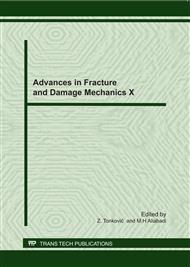p.202
p.206
p.210
p.214
p.218
p.222
p.226
p.230
p.234
Study on Welding Deformations of Shipboard of Container Vessel
Abstract:
Residual plastic strains of the shipboard are the product of nonlinear behaviors during welding. Deformations of a welded shipboard injure the beauty of appearance of the ship, cause errors during the assembly of the shipboard and reduce the strength of the ship. Residual welding deformations of shipboard of a container vessel are studied in this paper. Nonlinear three dimensional transient temperature fields are analyzed by FEM first. The heat source is modeled as a moving heat flux following a Gaussian distribution. Then, applying the equivalent loads induced by the inherent strain on the shipboard, the final in-plane shrinkage and out-of-plane deformations are calculated. Being compared with the experimental results of deformations, the simulated results show mostly conformity.
Info:
Periodical:
Pages:
218-221
Citation:
Online since:
September 2011
Authors:
Price:
Сopyright:
© 2012 Trans Tech Publications Ltd. All Rights Reserved
Share:
Citation:


